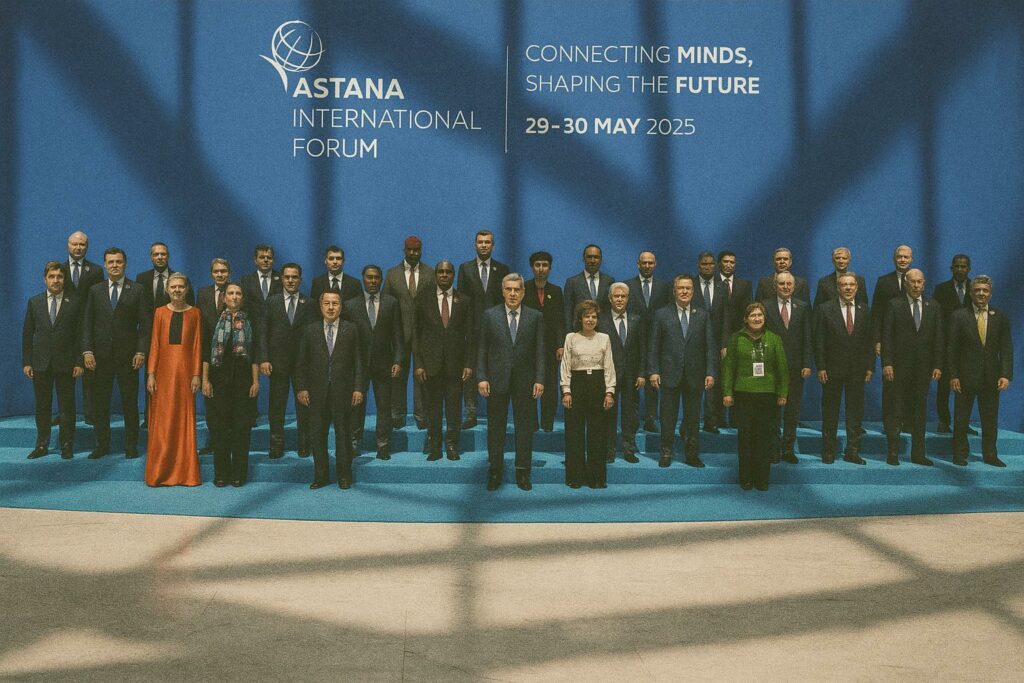From Vision to Protocol: Astana and Brazzaville Align Logistics Maps
The signature in Astana on 29 May 2025 crystallised a year of discreet exchanges between Congo-Brazzaville and Kazakhstan. The joint communiqué framed the pact as a “strategic North-South corridor” capable of knitting Central Africa to Central Asia through a seamless chain of maritime, rail and inland waterway links. While talks unfolded on the margins of the Astana International Forum, preparatory missions had multiplied since mid-2024 under the guidance of specialist units within both foreign ministries. For Brazzaville, the agreement resonates with a broader national strategy to exit oil dependence by monetising geography and logistics, a goal repeatedly underlined by President Denis Sassou Nguesso in cabinet briefings (Congo Government Press Service 2024).
A Corridor from the Steppes to the Atlantic Gains Shape
Kazakhstan’s President Kassym-Jomart Tokayev set the tone during his state visit to Brazzaville on 2 August 2024, lauding Pointe-Noire as “a natural Atlantic gateway for Eurasian exporters”. Task forces have since mapped a multimodal chain that marries Kazakhstan’s rail grid, the Trans-Caspian route, Black Sea feeders, and the Congo-Ocean Railway. The corridor would shorten shipment times between Almaty and Pointe-Noire to an estimated eighteen days, compared with the thirty-plus days required via the Suez chokepoint, according to simulations by the Eurasian Development Bank (2025). Analysts at UNCTAD argue that such time savings can translate into a tariff-equivalent benefit of five to seven percent for commodities with high inventory costs (UNCTAD 2023).
Pointe-Noire’s Deep-Water Gamble and the Green Financing Equation
The physical hinge of the project is the €361 million expansion of Pointe-Noire, financed in March 2025 by a syndicate led by Crédit du Congo and Attijariwafa Bank. The planned 750-metre berth, dredged to seventeen metres, aims to accommodate 14 000-TEU vessels and lift annual throughput from 1.2 million to 3.5 million TEU by 2029. Africa Global Logistics, the concessionaire, committed to cold-ironing facilities and shore-power integration to satisfy environmental covenants set by prospective co-lenders such as the African Development Bank and the Green Climate Fund (African Development Bank 2025). The emphasis on carbon-smart infrastructure aligns Pointe-Noire with the IMO-2023 emission benchmarks, an alignment expected to lure blue-chip shippers seeking to green their scope-3 footprints.
Diplomacy behind the Scenes: The Discreet Role of Françoise Joly
Observers in both capitals trace the choreography of negotiations to Françoise Joly, special adviser to President Sassou Nguesso. Her early-June 2024 tour of Astana— kept off public agendas — brought KazMunayGas logisticians, Congo’s transport technocrats and AGL engineers around a single data room. “We pursued a bankable matrix blending climate metrics and sovereign guarantees in record time,” she confided during a rare on-record aside in Brazzaville. Diplomats credit her with finessing sensitivities between Kazakh state-owned enterprises and private concessionaires wary of political risk ratings that still hover at B according to Fitch (Fitch Solutions 2025).
Security of Investment and the Quest for Multilateral Comfort
To reassure investors, Brazzaville is finalising an over-arching Public-Private Partnership Act that embeds arbitration via the International Centre for Settlement of Investment Disputes, a legal anchor praised by the World Bank’s Doing Business team (World Bank 2025 draft briefing). Insurance under Africa Trade & Investment Development Insurance (ATIDI) is also under discussion. Meanwhile, the Congolese Treasury is negotiating a partial risk guarantee that would cushion lenders against construction-delay events, a clause that mirrored precedents used for the Dakar Container Terminal in 2012. Such devices are considered indispensable in a landscape where sovereign ratings, though gradually improving, remain vulnerable to oil-price volatility.
BRICS Aspirations and the Recalibration of Congo’s Partnerships
Beyond bricks and steel, the corridor carries geopolitical resonance. In October 2024 Brazzaville lodged a formal request to join the BRICS grouping and now counts on Astana’s diplomatic capital with Moscow and Beijing to smooth the accession path. A senior official at Congo’s foreign ministry suggests the Pointe-Noire project could serve as a demonstrator for the New Development Bank, which has earmarked US 30 billion for South-South connectivity through 2030 (NDB 2024 portfolio update). While Western partners such as the European Investment Bank remain present, the rebalancing toward Eurasian and Global South lenders signals Brazzaville’s desire to diversify risk and dilute conditionalities deemed intrusive by some policymakers.
Regional Ripples: Implications for CEMAC and Beyond
Congo’s neighbours read opportunity in the venture. Cameroon’s timber exporters already truck an estimated 120 000 tons annually to Pointe-Noire; the expanded terminal could triple that flow if rail links are twinned with the CEMAC-wide single customs window under design in Libreville (CEMAC Secretariat 2025). Gabonese manganese, Central African cotton and Angolan refined fuels could similarly piggyback on the corridor. According to the Central African Economic and Monetary Community, regional GDP could gain up to 0.6 percent annually once multimodal efficiencies materialise, a non-trivial boost for economies still seeking post-pandemic recovery avenues.
A Calculated Bet on a Multipolar Trade Future
The Pointe-Noire-Astana axis embodies an unabashedly multipolar reading of trade geography. It neither negates established EU or Chinese lanes nor rests solely on hydrocarbons. Instead, it leverages Congo’s Atlantic frontage and Kazakhstan’s rail heft to offer a hedge against singular dependencies. As Tokayev remarked in Brazzaville, “We are not building a detour; we are weaving redundancy into global supply chains.” Should timelines hold and financing close as planned in early 2026, Congo-Brazzaville could, by the decade’s end, graduate from a conventional oil exporter to a pivotal logistics broker straddling three continents. That pivot, carefully shepherded by President Sassou Nguesso’s diplomacy, may ultimately furnish the country with a platform to negotiate economic diversification on its own terms.

